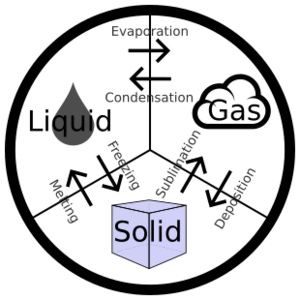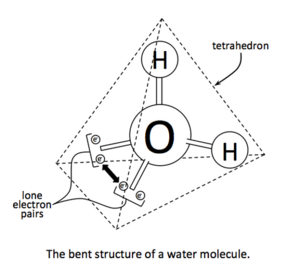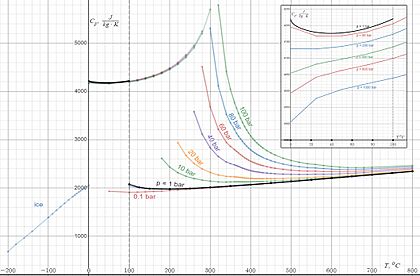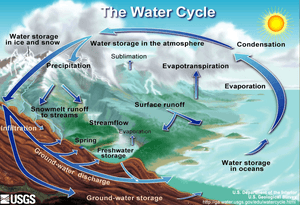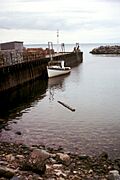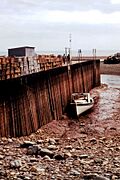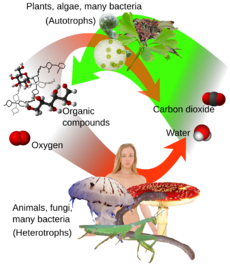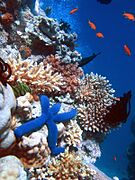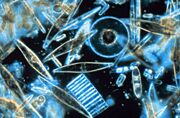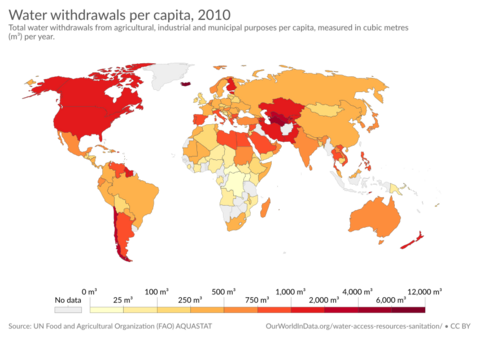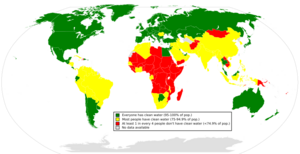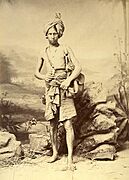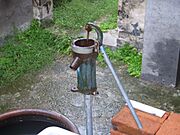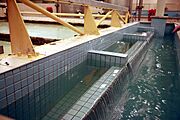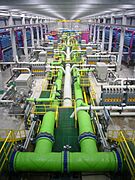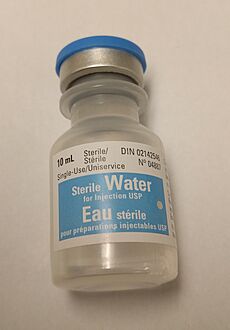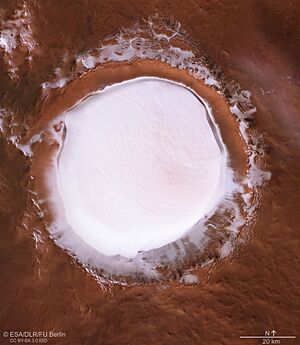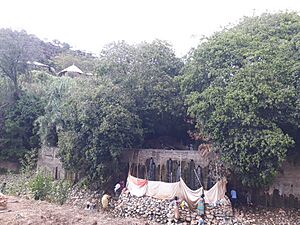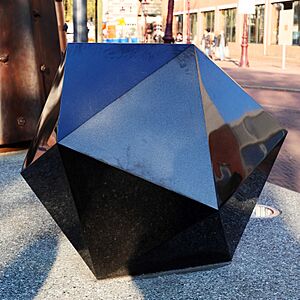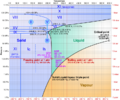Water facts for kids
Water is a simple chemical compound made of two hydrogen atoms and one oxygen atom, written as H
2O. It is clear, has no taste or smell, and is almost colorless. Water is everywhere on Earth, making up most of our planet's water systems and the liquids inside all living things. It helps dissolve many substances, which is why it's often called the "universal solvent."
Water is super important for all life, even though it doesn't give us energy or nutrients. Its special properties, like how its molecules stick together, make it unique. On Earth, water can be found as a solid (ice), a liquid (water), and a gas (water vapor or steam). You see it as rain, fog, clouds, and snow.
About 71% of Earth's surface is covered by water, mostly in oceans and seas. A smaller amount is found underground, in glaciers, and in the air as vapor and clouds. Water is always moving in a big loop called the water cycle. This cycle includes water evaporating, forming clouds, falling as rain or snow, and then flowing back to the oceans.
Water is also very important for our world's economy. About 70% of the fresh water we use goes to agriculture to grow food. Fishing in both fresh and salt water provides a lot of food. Many goods are transported across oceans and rivers by boats. Industries and homes use water for cooling and heating. Water is also key for cooking, washing, and many fun sports like swimming, surfing, and skiing.
Contents
Amazing Properties of Water
Water (H
2O) is a polar inorganic compound. At normal temperatures, it is a liquid with no taste or smell. It looks almost colorless, but can have a slight blue tint. Water is known as the "universal solvent" because it can dissolve more substances than any other liquid. This is why it's so important for life. Natural water always has things dissolved in it. To get truly pure water, special cleaning steps are needed. Water is the only common substance that exists as a solid, liquid, and gas under normal conditions on Earth.
Water's Different States
Water can be a liquid, a solid (ice), or a gas (water vapor or steam). When you add or remove heat, water changes its state.
- Freezing: Liquid water turns into ice.
- Melting: Ice turns back into liquid water.
- Vaporization: Liquid water turns into vapor (like when water boils or evaporates).
- Condensation: Vapor turns back into liquid water (like clouds forming).
- Sublimation: Ice turns directly into vapor without becoming liquid.
- Deposition: Vapor turns directly into ice (like frost forming).
Why Ice Floats: Water's Density
Water is special because it becomes less dense as it cools down, especially when it freezes. Most substances get denser when they cool. Water is densest at about 4°C (39°F). Below this temperature, it starts to expand. When water freezes into ice, it expands by about 9%. This is why ice floats on water!
This unusual property is very important for life on Earth. In a lake, colder, denser water sinks, but ice forms on the surface. This floating ice acts like a blanket, insulating the water below and stopping the whole lake from freezing solid. Without this, many aquatic organisms would not survive winter.
Taste and Smell of Water
Pure water usually has no taste or smell. However, water from nature, like mineral water, often has dissolved minerals and other substances. These can give it different tastes and smells. Humans and animals have senses to help them find safe water to drink and avoid water that is too salty or dirty.
The Color of Water
Pure water looks blue. This is because water absorbs some colors of light, especially red light. You can see this blue color easily in a glass of tap water against a white background in daylight. The deeper the water, the bluer it appears. In nature, water can look green if it has tiny particles or algae floating in it.
Sunlight can reach hundreds of meters deep in water, allowing aquatic plants and algae to grow. However, below about 1000 meters in the ocean, almost no sunlight reaches.
Water's Molecular Polarity
In a water molecule, the two hydrogen atoms and one oxygen atom form a bent shape. The oxygen atom pulls electrons more strongly than the hydrogen atoms. This gives the oxygen a slight negative charge and the hydrogens a slight positive charge. Because of this, water is a polar molecule.
This polarity makes water a great solvent. It can dissolve many salts and other polar substances like sugars and alcohols. Water also dissolves gases like oxygen and carbon dioxide, which gives fizzy drinks their bubbles. Many important substances in living things, like proteins and DNA, dissolve in water.
Some substances, like fats and oils, are hydrophobic (water-fearing) and do not dissolve in water.
Hydrogen Bonds: Water's Sticky Nature
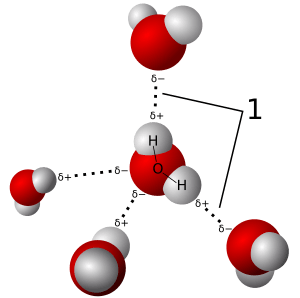
Because water molecules are polar, they are attracted to each other. The slightly positive hydrogen of one water molecule is attracted to the slightly negative oxygen of another. These attractions are called hydrogen bonds. They are much stronger than the forces between molecules in most other liquids.
Hydrogen bonds explain why water has high melting and boiling points. They also give water its high specific heat capacity, meaning it takes a lot of energy to heat up or cool down. This helps water moderate Earth's climate by storing and moving heat.
These bonds also cause water's high surface tension (why water forms drops) and capillary action. Capillary action is how water can move up narrow tubes, like inside plants, against gravity. This is vital for all vascular plants, including trees.
Water and Electricity
Pure water does not conduct electricity very well. However, if you dissolve a small amount of salt or other ionic substances in it, the water becomes a better conductor.
You can split liquid water into hydrogen and oxygen gases by passing an electric current through it. This process is called electrolysis.
Water on Earth
Hydrology is the study of how water moves, is distributed, and its quality across Earth. It looks at water on the surface, underground, and in the air. All the water on Earth—in oceans, lakes, rivers, glaciers, and the atmosphere—is called the hydrosphere. Earth has about 1.386 billion cubic kilometers of water.
Water is found in oceans, seas, lakes, rivers, and even small puddles. Most of Earth's water is seawater. Water also exists as groundwater in underground layers called aquifers.
Water plays a big role in shaping our planet's geology. It helps break down rocks through weathering and moves sediment around, creating river valleys and deltas.
The Water Cycle
The water cycle is the continuous movement of water on, above, and below the surface of the Earth. It's how water is recycled naturally.
Here's how it works:
- Evaporation and Transpiration: Water turns into vapor and rises into the air from oceans, lakes, and plants.
- Condensation: Water vapor in the air cools and forms tiny droplets, creating clouds.
- Precipitation: Water falls back to Earth as rain, snow, or hail.
- Runoff: Water flows over the land, often collecting in rivers and eventually reaching the sea.
Most water vapor comes from the ocean and returns there. However, winds carry a lot of water vapor over land, where it falls as precipitation. Sometimes, when water vapor meets a cool surface, it condenses into small drops called dew.
When rivers overflow, it causes a flood. On the other hand, a drought is a long period with very little rain, leading to water shortages.
Water Resources
Water resources are natural sources of water that humans can use, like for drinking or watering crops. Water can be stored in lakes, underground aquifers, and as ice and snow. About 69% of the world's fresh water is stored in glaciers and ice caps. Another 30% is groundwater, and only 1% is in lakes, rivers, and the atmosphere.
Some regions rely heavily on water stored underground for thousands of years. If too much water is taken out faster than it can be refilled, these water sources can decrease.
Seawater and Tides
Seawater contains about 3.5% salt, mostly sodium chloride. This makes it different from fresh water. Seawater freezes at a lower temperature (around -1.9°C or 28.6°F). Its density also increases as it gets colder, right up to its freezing point.
Tides are the regular rising and falling of sea levels. They are caused by the gravitational pull of the Moon and the Sun on Earth's oceans. Tides change the depth of water in coastal areas and create currents. The area of the seashore that is covered at high tide and exposed at low tide is called the intertidal zone, and it's home to many unique creatures.
- The Bay of Fundy at high tide and low tide
Water's Importance for Life
Water has many special properties that are essential for life to exist and thrive. It allows complex chemical reactions to happen, which are necessary for living things to grow and reproduce. All known forms of life need water.
Water is a key solvent inside our bodies, dissolving many substances. It's also a vital part of many metabolic processes. Metabolism is all the chemical reactions that happen in living things. For example, in some processes, water is removed to build larger molecules. In others, water is used to break down molecules to get energy. These processes cannot happen without water.
Water is also fundamental for photosynthesis and cellular respiration. Plants use sunlight to split water, combining hydrogen with carbon dioxide to make sugar and release oxygen. All living cells then use these sugars, combining them with oxygen to get energy, reforming water and carbon dioxide.
Water also helps keep the body's pH balanced. Pure water is neutral, with a pH of 7. Acids have a pH lower than 7, and bases have a pH higher than 7.
Aquatic Life Forms
Earth's waters are full of life. The first life forms appeared in water. Most fish live only in water, and there are many marine mammals like dolphins and whales. Some animals, like amphibians, live part of their lives in water and part on land. Plants like kelp and algae grow in water and form the base of underwater ecosystems. Tiny organisms called plankton are the foundation of the ocean food chain.
Aquatic animals get oxygen in different ways. Fish have gills instead of lungs. Marine mammals must come to the surface to breathe air. Some amphibians can absorb oxygen through their skin.
-
Some of the biodiversity of a coral reef
-
Some marine diatoms – a key phytoplankton group
-
Squat lobster and Alvinocarididae shrimp at the Von Damm hydrothermal field survive by altered water chemistry.
Water and Human Civilization
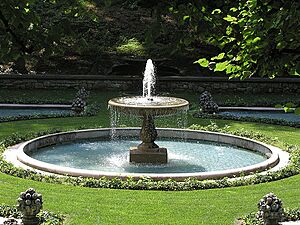
Throughout history, civilizations have grown around rivers and major waterways. Ancient societies like those in Mesopotamia and Egypt depended on rivers like the Tigris, Euphrates, and Nile. Many large cities today, such as London and New York City, became successful because of their easy access to water for trade. In places where water is scarce, like parts of North Africa, access to clean drinking water has always been crucial for human development.
Health and Water Pollution

Water that is safe for humans to drink is called drinking water or potable water. If water is not safe, it can be made safe by filtering, distillation, or other methods. Sadly, over 660 million people still do not have access to safe drinking water.
Water that is safe for swimming or bathing, but not necessarily drinking, is sometimes called "safe water for bathing." Chemicals like chlorine are often used to make water safe for these uses.
Water reclamation is the process of cleaning wastewater (like sewage) so it can be reused for other purposes. Many people live in areas with water scarcity, meaning there isn't enough water to meet everyone's needs. About 380 billion cubic meters of wastewater are produced globally each year.
Freshwater is a renewable resource because it's recycled by the water cycle. However, problems arise because water isn't evenly distributed, and there's growing demand from farming, industry, and increasing populations. Poor water quality and bad sanitation cause millions of deaths each year from water-related diseases. The World Health Organization believes that safe water could prevent 1.4 million child deaths from diarrhea every year.
In many developing countries, most wastewater is released into rivers and streams without treatment. This causes significant water pollution. Many countries face water shortages, and some use more water each year than their natural water cycles can replenish. This affects both surface water and underground water sources.
How Humans Use Water
Agriculture
The biggest use of water by humans is for agriculture, especially for irrigation of crops. This accounts for 80% to 90% of all water consumed by humans. In the United States, 42% of freshwater used goes to irrigation.
Access to fresh water is often taken for granted in developed countries with good water systems. However, growing populations, economies, and climate changes are increasing concerns about water. This leads to more competition for limited water resources. Experts predict that water challenges will increase as demand for food, meat, and new industries grows.
A study in 2007 looked at water management in agriculture. It found that about 1.2 billion people live in areas with physical water scarcity, meaning there isn't enough water to meet all needs. Another 1.6 billion people live in areas with economic water scarcity, where there isn't enough investment or capacity to provide water. The report concluded that we can produce enough food in the future, but only if farmers increase productivity and industries and cities use water more efficiently.
Water scarcity is also caused by making products that need a lot of water. For example, one kilogram of cotton (enough for a pair of jeans) needs about 10,900 liters of water. This water is often used in regions already facing water shortages. A famous example of environmental damage is the drying up of the Aral Sea, caused by diverting rivers for cotton farming.
-
Irrigation of field crops
For Drinking
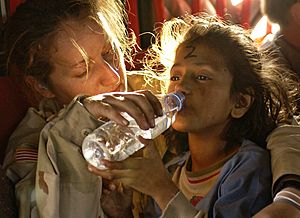
The human body is made up of about 50-60% water. The amount of water a person needs each day depends on their activity level, temperature, and other factors. The U.S. National Academies of Sciences recommends about 3.7 liters (about 15 cups) of water for adult men and 2.7 liters (about 11 cups) for women daily. Most of this comes from food and other drinks, not just plain water.
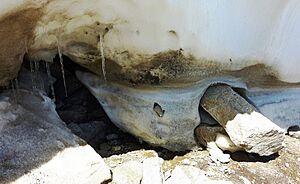
It's important not to drink too much water, especially during exercise, as this can be dangerous. The popular idea of drinking "eight glasses of water a day" isn't strictly backed by science. However, staying hydrated helps prevent problems like constipation.
Pregnant and breastfeeding women need more fluids. About 20% of our water intake comes from food, and the rest from drinks. Water leaves our bodies through urine, feces, sweat, and even when we breathe.
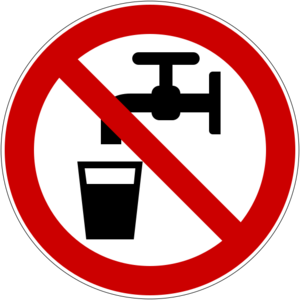
Humans need water with few impurities. Harmful impurities can include metals, chemicals like pesticides, and bacteria. Some dissolved substances are good, though, as they can improve taste and provide needed electrolytes. The largest single source of fresh drinking water is Lake Baikal in Siberia.
Washing
Water is essential for washing ourselves, our clothes, and our homes. It helps us stay clean and healthy.
Transportation
Waterways have been used for transportation for thousands of years. Rivers, lakes, and oceans allow boats and ships to carry goods and people across long distances. This has been vital for trade and connecting different parts of the world.
Heat Exchange
Water and steam are often used for heat exchange, both for cooling and heating. This is because water is readily available and has a high heat capacity, meaning it can absorb a lot of heat without its temperature changing too much. It's especially good at moving heat when it changes from liquid to steam and back again, due to its large latent heat of vaporization.
In almost all thermal power stations, water is used to create steam that drives turbines to generate electricity. It's also used to cool down the power plants. In the United States, cooling power plants is the biggest use of water.
In nuclear power plants, water is used both to cool the reactor and to slow down the nuclear reaction. This helps keep the reactor safe.
Fire Fighting
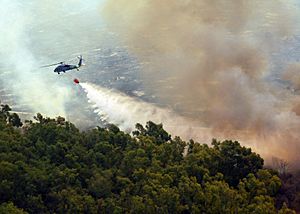
Water is a good fire extinguishing fluid because it has a high heat of vaporization and is relatively stable. When water evaporates, it takes a lot of heat away from the fire, helping to put it out.
However, it can be dangerous to use water on fires involving oils or organic solvents, as these can float on water and spread the fire. Also, using water on very hot fires in enclosed spaces can cause a steam explosion. Water can also react with certain hot metals or carbon to produce flammable gases, which can lead to a hydrogen explosion.
Recreation

Humans use water for many fun activities and sports. These include swimming, waterskiing, boating, surfing, and diving. Sports like ice hockey and ice skating are played on ice. Beaches, lakes, and water parks are popular places to relax. Many people find the sound of flowing water calming, and fountains are common decorations. Some people keep fish in aquariums or ponds. Water is also used for snow sports like skiing and snowboarding.
Water Industry
The water industry provides drinking water and wastewater services. This includes water wells, systems to collect rainwater, water supply networks, and water purification facilities.
Drinking water is often collected from springs, pumped from underground wells, or taken from lakes and rivers. This water often needs to be cleaned to remove dirt, dissolved substances, and harmful microbes. Common cleaning methods include filtering with sand, chlorination to kill microbes, and boiling. More advanced methods like reverse osmosis are also used. Desalination, which removes salt from seawater, is a more expensive way to get fresh water, used in dry coastal areas.
Clean drinking water is delivered through city water systems, by tanker trucks, or as bottled water. Some cities, like Hong Kong, use seawater for flushing toilets to save fresh water.
Polluting water is a major problem. When pollutants limit how water can be used, it wastes this valuable resource. This pollution often harms local communities, while the companies causing it may not pay for the damage. Chemicals from medicines can also end up in waterways, potentially harming aquatic life.
Wastewater from homes and industries is usually treated at wastewater treatment plants before being released.
-
A manual water pump in China
-
Water purification facility
-
Reverse osmosis (RO) desalination plant in Barcelona, Spain
Industrial Applications
Many industrial processes use water. Chemicals are dissolved in water for reactions, solids are mixed with water to form slurries, and water is used to dissolve and extract substances or to wash equipment. Industries like mining, paper manufacturing, and textile production use large amounts of water. They also often cause significant water pollution if the wastewater is not treated.
Water is also used to generate power. Hydroelectricity is electricity made from the power of moving water. A dam is built on a river, creating a lake. Water flowing out of the lake turns turbines, which then generate electricity. This is a low-cost, clean, and renewable energy source.
High-pressure water is used in water blasting and water jet cutters for precise cutting. This method is effective, safe, and not harmful to the environment. Water also cools machinery to prevent overheating.
Food Processing
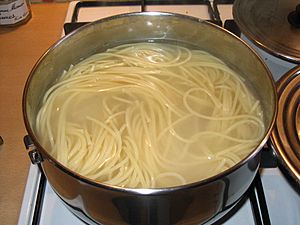
Water is used in many ways to prepare food. Boiling, steaming, and simmering all involve cooking food in water or steam. Water is also used for dishwashing.
Substances like salts and sugars dissolved in water change its properties. They affect the boiling and freezing points. For example, adding salt to water makes it boil at a higher temperature and freeze at a lower temperature. This is important for cooking and preserving food.
The "hardness" of water, which depends on the amount of minerals like calcium it contains, is also important in food processing. It can affect the quality of food products and how well things get cleaned.
Medical Use
Water for injection is a very important medicine. It is used to dissolve other medicines before they are given to patients.
Water in the Universe

Much of the water in the universe is created when stars form. When gas and dust are pushed out from a new star, they crash into surrounding gas, heating it up and creating water.
In 2011, scientists found a huge cloud of water vapor around a distant quasar. This cloud contained "140 trillion times more water than all of Earth's oceans combined." This discovery shows that water has been present in the universe for almost its entire existence.
Water has also been found in clouds of gas and dust within our own Milky Way galaxy. Since hydrogen and oxygen are very common elements, water is likely abundant in other galaxies and star systems too.
Water Vapor in Space
Water exists as vapor in the atmospheres of many planets and moons:
- Mercury
- Venus
- Earth
- Mars
- Jupiter and its moon Europa
- Saturn and its moons Enceladus (91% water vapor!) and Dione
- Uranus
- Neptune
- Many planets outside our solar system (exoplanets)
- Even in the atmospheres of some stars!
Liquid Water in Space
Liquid water is common on Earth, covering 71% of its surface. Small amounts of liquid water have also been found on Mars. Scientists believe there are oceans of liquid water under the icy surfaces of Saturn's moons Enceladus and Titan. Jupiter's moons Europa and Ganymede may also have subsurface liquid water oceans.
Water Ice in Space
Water is present as ice in many places:
- Mars: under the surface and at its poles.
- Earth and the Moon: mostly as ice sheets on Earth, and in craters on the Moon.
- Ceres (a dwarf planet).
- Jupiter's moons: Europa, Ganymede, and Callisto.
- Saturn: in its rings and on the surfaces of moons like Titan and Enceladus.
- Pluto and its moon Charon.
- Comets and other icy objects in the outer solar system.
It is also likely present on Mercury's poles and Tethys.
Water and Planetary Habitability
The presence of liquid water on Earth is crucial for life as we know it. Earth is in the "habitable zone" of our Solar System, meaning it's just the right distance from the Sun for liquid water to exist. If Earth were a little closer or farther away, liquid water would be much less likely.
Earth's size is also important. Its gravity holds onto an atmosphere that includes water vapor. This water vapor, along with carbon dioxide, helps keep Earth's temperature stable through the greenhouse effect.
The state of water on a planet also depends on pressure. On very massive exoplanets, water can be solid even at high temperatures because of the extreme pressure from gravity.
Water: Laws, Challenges, and Global Efforts
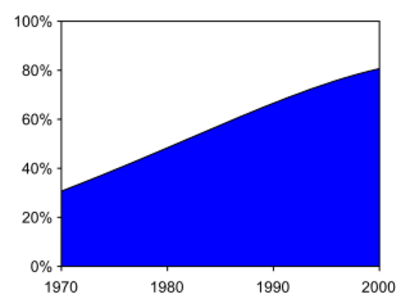
Water politics refers to how water resources affect political decisions and conflicts. Because fresh water is so important, it can be a source of tension between countries or regions. Water issues also impact health and the environment.
Access to safe drinking water has improved greatly in recent decades. However, about one billion people still lack safe water, and over 2.5 billion lack proper sanitation. Experts estimate that by 2025, more than half of the world's population could face water shortages. A report from 2009 suggested that by 2030, water demand in some developing regions could be 50% higher than the supply.
Since 1990, 1.6 billion people have gained access to a safe water source. The percentage of people in developing countries with access to safe water improved from 30% in 1970 to 84% in 2004.
A 2006 United Nations report stated that "there is enough water for everyone," but that poor management and corruption often prevent people from accessing it. In 2015, the UN set Sustainable Development Goals to achieve universal access to safe and affordable water and sanitation by 2030.
Poor management of water resources is a key reason for water scarcity. This involves how decisions about water are made. It's important to find solutions that work best for each specific place.
Organizations like WaterAid and the International Water Management Institute work to protect water and improve access. World Day for Water is celebrated on March 22, and World Oceans Day on June 8, to raise awareness about water issues.
Water in Culture
Religion
Water is seen as a purifier in most religions. Many faiths include ritual washing or ablutions, such as Christianity, Hinduism, Islam, and Judaism. Baptism in Christianity involves immersing a person in water. In Islam, people perform wudu (washing certain body parts) before daily prayers. In Shinto, water is used in almost all rituals for cleansing.
In Christianity, holy water is blessed by a priest and used for baptisms, blessings, or to repel evil. In Zoroastrianism, water is respected as the source of life.
Philosophy
Ancient Greek philosophers like Thales believed that all things were made from water. Empedocles saw water as one of the four basic elements, along with fire, earth, and air. Plato thought that the shape of water was an icosahedron, which explained why it flowed easily.
In traditional Chinese philosophy, water is one of the five elements. Many Asian philosophies use water as a role model, admiring its ability to benefit all things and its gentle strength.
Folklore
In many old stories and folktales, "living water" has magical powers, sometimes even bringing the dead back to life. The Fountain of Youth is another legend about magical waters that supposedly prevent aging.
Art and Activism
Artists and activists often use water as a theme to highlight its importance. Exhibitions like The Value of Water showcase how artists explore our dependence on water. Groups like Think About Water bring together artists who focus on water in their work.
To mark the 10th anniversary of access to water and sanitation being declared a human right by the UN, the charity WaterAid asked artists to show the impact of clean water on people's lives.
The Dihydrogen Monoxide Prank
The name 'Dihydrogen monoxide' is a scientific way to say water, but it's rarely used. This name has been part of several hoaxes and pranks that make fun of people who don't know much about science. The prank started in 1983 with a fake news story that warned about the dangers of "dihydrogen monoxide," listing scary but true facts about water (like it can cause severe burns as steam, or is found in tumors), making it sound like a dangerous chemical.
Images for kids
Related pages
See also
 In Spanish: Agua para niños
In Spanish: Agua para niños
- Outline of water
- Water (data page) is a collection of the chemical and physical properties of water.
- Aquaphobia (fear of water)
- Human right to water and sanitation
- Hydroelectricity
- List of waterfalls
- Mpemba effect (why hot water can freeze faster than cold water)
- Oral rehydration therapy
- Properties of water
- Rainwater tank
- Thirst
- Water filter
- Water heat recycling
- Water recycling shower



